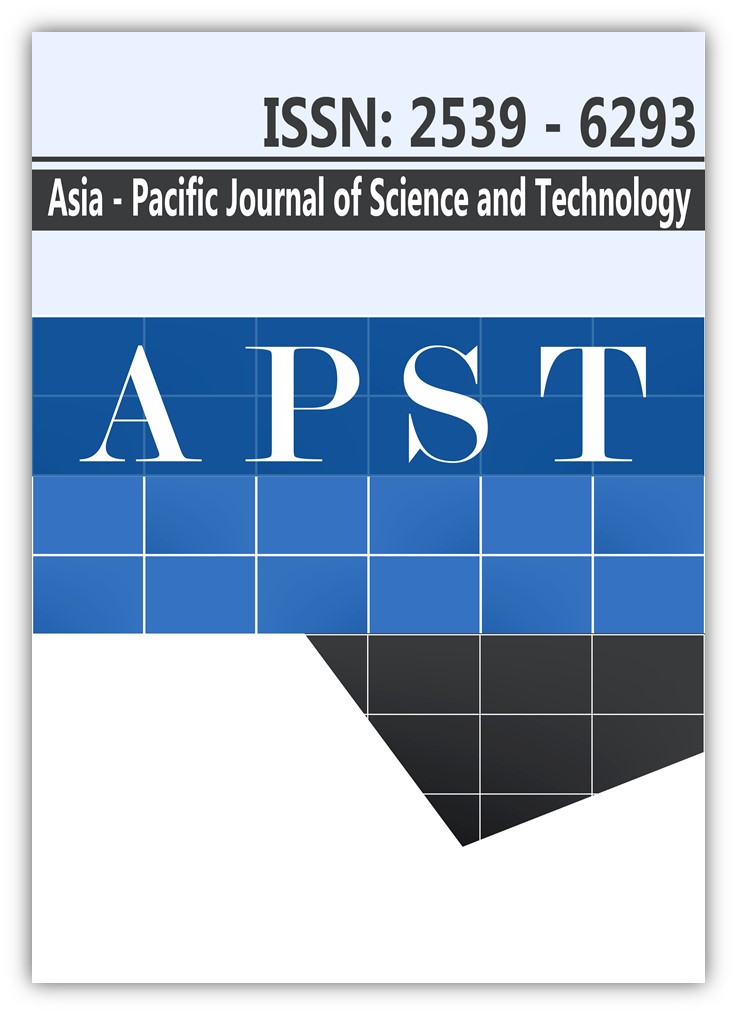Risk factors and prediction of the severity of respiratory diseases in domestic rabbits (Oryctolagus cuniculus)
Main Article Content
Abstract
This study examined the health information of domestic rabbits to find the risk factors and the relationship mortality rates due to respiratory diseases and to predict of the severity of the respiratory diseases by carrying out a prospective study. The study process involved collecting samples from healthy and sick rabbits with respiratory diseases. In total, there were 1,758 samples, which were divided into 1,000 healthy rabbits, 758 sick, and 210 dead rabbits. Age, sex, breed, density in rabbit husbandry, sanitation, and management had been related to illness. In order to investigate the relationship of the clinical symptoms, comparisons were made between the sick rabbits and those that had expired from respiratory diseases. The findings indicated that having the symptoms of oculonasal discharge and having a higher body condition score [Standard (Score=3) to obese (Score=5)] were not found in relation to the dead rabbits. The cause of the sick rabbits to have a higher mortality rate include 1) indicators of mental status, such as having depression or having a lower body condition score: [Emaciation (Score=1) to Underweight (Score =2)]; 2) increases in the respiratory rates and heart rates; 3) lung opacity pattern of interstitial, 4) an abnormal Complete blood count, and 5) blood chemistry parameters, such as Aspartate aminotransferase, Alanine aminotransferase, Alkaline phosphatase, Albumin, Gamma-glutamyltransferase, Blood Urea Nitrogen and creatinine. These values are used to predict the severity of respiratory diseases and to classify patient rabbits. This is the first report of severity index of respiratory diseases for domestic rabbits.
Article Details
References
Niederman MS, Mandell LA, Anzueto A, Bass JB, Broughton WA, Campbell GD, et al. Guidelines for the management of adults with community acquired pneumonia. Am J Respir Crit Care Med. 2001;163(7):1730-1754.
Amna BET, Teresa YM, Elisabeth JA. Evaluation of Pasteurella multocida isolated from rabbits by capsular typing, somatic serotyping and restriction endonuclease analysis. J Vet Diagn Invest. 2004;16(2):121-125.
Boyce JD, Chung JY, Adler B. Pasteurella multocida capsule: composition, function and genetics. J Biotecnol. 2000;83(1-2):153-160.
Brogden KA. Physiological and serological characteristics of 48 Pasteurella multocida cultures from rabbits. J Clin Microbiol. 1980;11(6):646-649
Cathy AJD, Susan EO. Rabbit respiratory system: clinical anatomy, physiology and disease. Vet Clin North Am Exot Anim Pract. 2011;14(2):257-266.
Coudert P, Rideaud P, Virag G, Cerrone A. Pasteurellosis in rabbits. In:Maertens L, Ciydert P, editors. Recent advances in rabbit sciences. Merelkebe: Polt-it bvba; 2006. p. 147-162.
Deeb BJ, Digiacomo RF, Bernard BL, Silbernagel SM. Pasteurella multocida and Bordeltella bronchiseptica infection in rabbits. J Clin Microbiol. 1990;28(1):70-75.
Ewig S, Schäfer H, Torres A. Severity assessment in community acquired pneumonia. Eur Respir J. 2000;16:1001-1007.
Hector R, Tina VH, Tebeb G, Kecia NC, Emma KL. A simple respiratory severity score that may be used in evaluation of acute respiratory infection. BMC Infect Dis. 2016;9:1-4.
Jaglic Z, Kucerova Z, Nedbalcova P, Jeklova E, Leva L, Kummer V, et al. Experimental study of pathogenicity of Pasteurella multocida serogroup F in rabbits. Vet Microbiol. 2007;126:168-177.
James C, Chris M. Exotic animal formulary. 5th ed. Kansas: Saunders; 2017.
Jamie R, Peter W. Pneumonia severity scores in resource poor settings. Pneumonia. 2014;5:30-37.
Kishore GM, Krishnakanth K, Gnana S, Pradeep K, Padma GM. Poisoning severity score, APACHE II and GCS: effective clinical indices for estimating severity and predicting outcome of acute organophosphorus and carbamate poisoning. J Forensic Legl Med. 2009;16:239-247.
Lena MN. Use of severity scoring and stratification factors in clinical trials of hospital-acquired and ventilator-associated pneumonia. Clin Infect Dis. 2010;51:67-80.
Michael JF, Thomas EA, Donald MY, Barbara HH, Lisa AW, Daniel ES, et al. A prediction rule to identify low-risk patients with acquired pneumonia. N Engl J Med. 2011;336(4):237-250.
Molly V. Rabbit medicine. 2nd ed. New York. The Kenneth S Warren institute; 2014.
Mostafa AM, Hooman B, Bareza R, Patricia K. Pneumonia severity index compared to CURB-65 in predicting the outcome of community acquired pneumonia among patients referred to an Irian emergency department: a prospective survey. Braz J Infect Dis. 2013;17(2):179-183.
Niederman MS, Feldman C, Richards GA. Combining information from prognostic scoring tools for CAP: an American view on how to get the best of all worlds. Eur Respir J. 2006;27:9-11.
Richard RW, Tracy LL. Diagnosis and management of community acquired pneumonia in adult. Am Fam Physician. 2011;83(11):1299-1306.
Ruttikan W. Preliminary study of respiratory infections in rabbits. In: Sirinya C, editor. VPAT Regional Veterinary Congress; 2011 May 8-11; Grand Diamond Ballroom and Sapphire 1-10. The Veterinary Practitioner Association of Thailand; Bangkok; 2011. p. 458-462.
Shin TM, Nelson L, Margaret L, Gregory EA, Shirley SC, Paulina M, et al. Effects of TNF- α and leptin on weight loss in patients with stable chronic obstructive pulmonary disease. Korean J Intern Med. 2007;22(4): 249-255.
Sonia L, Joaquim G, Pere S, Olivia F, Nuria B, Santiago G. Prospective comparison of severity score for predicting mortality in community acquired pneumonia. Rev Esp Quimioter. 2012;25(2):147-154.
Terdsak S. RDW or RDW-CV or RDW-SD can be used as a guideline for the classification of anemia. Tham. Lab. Thammasat Hospital Chaloem Phra Kiat; 2018;4(5):6-12.
Thomas W, Harald N, Marc AP, Hans JH, Ludger P, Ulrich T. Pneumonia severity, comorbidity and 1-year mortality in predominantly older adults with community-acquired pneumonia: a cohort study. BMC Infect Dis. 2015;15(2):1-6.


